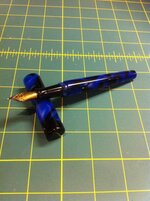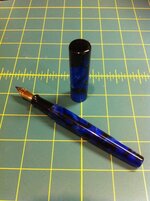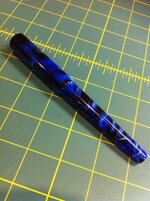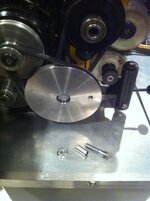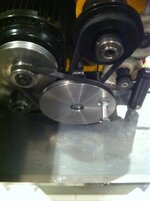duke851
Member
After finishing my first pen which I made from Ebonite (pictures in the advanced pen making section if you want a look) I wanted to try a different material so I used AA-05 Iridescent blue and black from Exotic blanks. It needed more care than the Ebonite but was also very nice to work with. Nib is a Jowo #6 broad with a Schmidt #5 converter. One of the things I tweaked from my first attempt was the thread sizes on the cap. I am much happier with the balance of this pen when it is posted.
Threads are as follows
Nib M7.4 x .5
Section M10 x .75
Cap M14 x .75
I also had my first attempt at a finial which I made from the same Woodcraft black acrylic I made the section. The Woodcraft acrylic gave me fits when I tried to thread it using a die but it worked well machine cutting the threads.
Since I took theses pictures I put the cap back on the mandrel and reduced the thickness by about 1/32" and I am much happier with the look. I also ordered a polished nib instead of the two tone which I think will work better.
Okay next! I think I want to try adding an accent band to the cap or maybe silver bands.
Colin
Threads are as follows
Nib M7.4 x .5
Section M10 x .75
Cap M14 x .75
I also had my first attempt at a finial which I made from the same Woodcraft black acrylic I made the section. The Woodcraft acrylic gave me fits when I tried to thread it using a die but it worked well machine cutting the threads.
Since I took theses pictures I put the cap back on the mandrel and reduced the thickness by about 1/32" and I am much happier with the look. I also ordered a polished nib instead of the two tone which I think will work better.
Okay next! I think I want to try adding an accent band to the cap or maybe silver bands.
Colin

